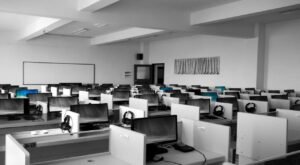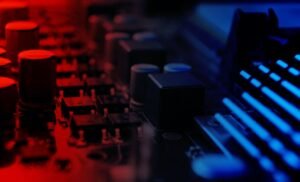Deepfake for Audio
Deepfake technology has gained significant attention in recent years for its ability to manipulate and generate realistic images and videos. However, its impact is not limited to the visual domain alone. Deepfake algorithms have also been developed to manipulate audio, creating what is known as deepfake for audio.
Key Takeaways
- Deepfake for audio is a technology that uses AI algorithms to create convincing fake audio recordings.
- It raises concerns about the potential for audio manipulation, misinformation, and its impact on trust.
- Deepfake detection methods are being developed to combat the spread of fake audio.
- Regulation and education are necessary to address the ethical and legal implications of audio deepfakes.
Deepfake for audio involves training machine learning models on large datasets of audio samples to learn the nuances of a particular speaker’s voice. These models can then generate new audio content that mimics the speaker’s voice, tone, and speech patterns. *This technology poses challenges in distinguishing genuine audio recordings from those that have been manipulated.*
As with visual deepfakes, concerns arise regarding the potential misuse of this technology. **Fake audio recordings can be used for impersonation, spreading false information, or even blackmail.** Furthermore, the rise of deepfake for audio raises significant questions about trust and the authenticity of audio evidence in various domains, including journalism, law enforcement, and personal communication.
The Challenges of Deepfake Detection
Detecting deepfake audio poses unique challenges compared to visual deepfakes. While visual manipulation can often be identified through visual artifacts, audio manipulation is more difficult to detect. Deepfake for audio can convincingly imitate a person’s voice, making it challenging for humans to discern between real and fake audio recordings.
*One interesting approach to detect deepfake audio involves analyzing speech patterns and inconsistencies in the audio signal using machine learning algorithms.* Researchers are developing techniques to identify subtle differences in pronunciation, intonation, and rhythm that may be indicative of a deepfake.
Regulation and Education
Addressing the threats posed by deepfake for audio requires a multi-faceted approach involving both regulation and education. Governments and organizations need to enact laws and regulations to prevent the malicious use of deepfake technology, especially for audio manipulation. Legal consequences should be in place to deter individuals from creating and circulating deepfake audio for harmful purposes.
*Additionally, education plays a crucial role in increasing public awareness about the existence and potential dangers of deepfake for audio.* People need to be informed about the technology and its implications to become more discerning audio consumers and avoid being misled by manipulated recordings.
Table 1: Comparison of Deepfake for Audio Detection Techniques
| Technique | Advantages | Challenges |
|---|---|---|
| Machine learning-based analysis | – Effective in identifying subtle audio patterns. – Able to adapt to new deepfake techniques. |
– Requires large training datasets. – Prone to false positives/negatives. |
| Signal processing analysis | – Less computationally intensive. – Good at detecting artifacts in manipulated audio. |
– Limited effectiveness against sophisticated deepfakes. – Requires expert knowledge for implementation. |
Table 2: Potential Impacts of Deepfake for Audio
| Domain | Potential Impacts |
|---|---|
| Journalism | – Undermining credibility of audio evidence. – Spreading misinformation through fake interviews or statements. |
| Law enforcement | – Creating false alibis or tampering with audio evidence. – Impersonating law enforcement officials. |
| Personal communication | – Facilitating voice-based identity theft. – Misleading and manipulating individuals through fake audio messages. |
Addressing the Future Challenges
The development and growth of deepfake for audio present numerous challenges, but these challenges can be overcome with collective efforts and advancements in technology. Collaboration between researchers, industry experts, and policymakers is crucial in developing more effective detection methods and regulating the use of deepfake technology.
*The fight against audio deepfakes requires continuous adaptation and vigilance, as perpetrators of misinformation constantly evolve their techniques.* By staying informed, raising awareness, and actively participating in combating audio deepfakes, we can help maintain trust and integrity in digital audio content.

Common Misconceptions
Paranoia and Spread of Misinformation
One common misconception about deepfake for audio is the belief that it is solely used for malicious purposes, such as spreading misinformation or manipulating public opinion. While it is true that deepfake technology can be used to create convincing fake audio clips, it is important to note that it also has positive applications.
- Deepfake audio can be used for entertainment purposes, such as voice acting or dubbing.
- It can also be used to improve accessibility for individuals with speech impairments.
- Deepfake technology can be leveraged in the development of virtual assistants for a more personalized experience.
Infallible Detection and Misrepresentation
Another misconception surrounding deepfake for audio is that there exists infallible detection methods to identify manipulated audio clips. While researchers and technology experts continue to develop robust detection techniques, it is challenging to achieve complete accuracy.
- False positives can occur, flagging authentic audio as deepfakes.
- Sophisticated deepfake techniques can still evade detection methods in some situations.
- The arms race between deepfake creators and detection algorithms keeps evolving.
Audio Deepfakes as Indisputable Evidence
A common misconception is that audio deepfakes can serve as irrefutable evidence in legal proceedings. While deepfakes can be used to manipulate or deceive, their reliability as evidence is often questioned.
- Experts can challenge the authenticity of deepfake audio by analyzing inconsistencies and artifacts.
- Legal systems require additional corroboration besides audio evidence for convictions.
- The admissibility of deepfake-generated evidence is still a topic of debate in many jurisdictions.
Seamless Generation of Authentic Sounding Voices
One misconception is that deepfake technology can seamlessly generate voices that are indistinguishable from real human voices. While advances have been made in voice synthesis, certain limitations still exist.
- Generating convincing sounding voices from limited data can be challenging.
- Capturing intonations and nuances of individual speakers is a complex task.
- Discrepancies may be noticeable to attentive listeners and experts.
Unidirectional Usage of Deepfake Technology
Deepfake technology is often associated with impersonating or faking someone’s voice, leading to a misconception that it can only be used for that purpose. However, this overlooks the multifaceted nature of deepfake applications.
- Audio deepfakes can be utilized in creative ways to enhance storytelling and immersive experiences.
- Diverse industries, including film, gaming, and advertising, can benefit from audio deepfake technology.
- Improving speech synthesis and text-to-speech systems is another potential application.

Deepfake for Audio
Deepfake technology has become increasingly powerful in recent years, enabling the creation of realistic yet fabricated media content. While deepfakes have mostly been associated with video manipulation, the emergence of deepfake for audio poses new challenges and concerns. In this article, we explore various aspects of deepfake for audio and present ten captivating tables that highlight key points, data, and other elements related to this evolving technology.
The Rise of Deepfake for Audio
Table showcasing the increasing number of deepfake audio applications and their purposes:
| Application | Purpose |
|---|---|
| Voice cloning | Impersonation or mimicry |
| Vocal editing | Post-production enhancements |
| Speech synthesis | Generating synthetic voices |
| Audio deepfakes | Manipulation of audio content |
Potential Misuses of Deepfake Audio
Table highlighting the various potential dangers associated with deepfake audio:
| Danger | Description |
|---|---|
| Vishing | Social engineering attacks through manipulated voice calls |
| Audio scams | Fabricated audio evidence for fraud or blackmail |
| Political manipulation | Generating false statements to manipulate public opinion |
| Misattribution | Attributing false statements or actions to individuals |
Methods Used in Deepfake Audio Creation
Table showcasing the different techniques employed in deepfake audio creation:
| Technique | Description |
|---|---|
| Traditional voice cloning | Recording and synthesizing voice clips |
| Text-to-Speech (TTS) | Generating speech from text input |
| Generative adversarial networks (GANs) | Training models to create realistic audio fabrications |
| Hybrid approaches | Combining multiple techniques for enhanced results |
Recognizing Deepfake Audio
Table presenting common indicators or techniques to identify deepfake audio:
| Indicator | Description |
|---|---|
| Inconsistencies | Detecting changes in voice characteristics or tone |
| Anomalies in waveform | Identifying irregularities when analyzing the audio’s waveform |
| Unnatural pauses or breaks | Recognizing unusual gaps or hesitations in speech |
| Error artifacts | Artifacts resulting from the deepfake audio manipulation |
Legal Implications of Deepfake Audio
Table illustrating the legal considerations surrounding deepfake audio:
| Issue | Explanation |
|---|---|
| Privacy violations | Unauthorized use of recorded voices for malicious purposes |
| Defamation | False audio content causing harm to an individual’s reputation |
| Intellectual property | Unauthorized use of copyrighted or licensed audio |
| Security concerns | Potential threats arising from manipulated audio evidence |
Mitigating the Impact of Deepfake Audio
Table presenting possible techniques to minimize the impact of deepfake audio:
| Technique | Description |
|---|---|
| Authenticity verification | Implementing procedures to validate audio authenticity |
| Deepfake detection tools | Developing technology to identify deepfakes |
| Public awareness campaigns | Educating the public about the presence and threats of deepfake audio |
| Legal frameworks and regulation | Establishing laws to address deepfake audio usage and consequences |
Deepfake Audio vs. Authentic Audio
Table comparing deepfake audio to authentic audio through various factors:
| Comparison Factor | Deepfake Audio | Authentic Audio |
|---|---|---|
| Accuracy | Imitated or altered | Original and unchanged |
| Verifiability | Questionable and potentially misleading | Authentic and transparent |
| Trustworthiness | Dubious and subject to manipulation | Reliable and trustworthy |
| Consistency | May exhibit inconsistencies or artifacts | Consistent and natural |
Potential Applications of Deepfake Audio
Table showcasing the potential positive uses of deepfake audio:
| Application | Benefit |
|---|---|
| Voice restoration | Recreating voices lost due to injury or illness |
| Accessibility | Allowing people with speech impairments to generate voices |
| Language learning | Simulating different accents or dialects for language practice |
| Artistic expression | Creative audio manipulation for artistic purposes |
Existing Deepfake Audio Technologies
Table highlighting prominent deepfake audio technologies and their creators:
| Technology | Creator |
|---|---|
| Lyrebird | Lyrebird AI |
| Google Duplex | |
| VoiceCloning | Resemble AI |
| Descript | Descript Inc. |
Conclusion
Deepfake for audio represents a significant advancement in the realm of media manipulation, raising concerns about deception, privacy violations, and potential threats to security and trust. As illustrated by these tables, the rise of deepfake audio presents various risks, including vishing attacks, political manipulation, and defamation. Identifying deepfake audio is crucial in combating its negative impact, and mitigation techniques such as authenticity verification, public awareness campaigns, and legal frameworks are essential. While deepfake audio carries profound implications, it also offers potential benefits in voice restoration, accessibility, language learning, and artistic expression. As this article demonstrates, understanding and addressing the challenges posed by deepfake for audio are essential to safeguarding the integrity of our increasingly digital world.
Frequently Asked Questions
What is deepfake for audio?
Deepfake for audio refers to the use of artificial intelligence (AI) algorithms to create manipulated or synthetic audio content that sounds like it was spoken by a particular individual, even if they never said those words.
How does deepfake for audio work?
Deepfake for audio utilizes deep learning techniques such as neural networks to analyze and synthesize voice data. The AI model is trained on large datasets of target voice samples to learn the speaker’s vocal characteristics and then generate new audio content mimicking their voice patterns.
What are the potential applications of deepfake for audio?
Deepfake for audio has both positive and negative applications. It can be used in entertainment industries to create realistic voice imitations for movies and video games. However, it can also be exploited for malicious purposes, such as voice impersonation, spreading disinformation, or fabricating false evidence.
Are deepfake audio clips distinguishable from real ones?
With advancing technology, deepfake audio clips are becoming increasingly difficult to distinguish from real ones, especially to an untrained ear. However, experienced audio professionals or technology experts may be able to identify certain anomalies or artifacts present in the synthetic audio.
Is deepfake audio illegal?
Whether deepfake audio is illegal or not depends on the jurisdiction and context in which it is used. The use of deepfake audio to deceive, defraud, or harm others could potentially be considered illegal. However, the laws surrounding deepfake technology are still evolving, and each case needs to be evaluated on an individual basis.
Can deepfake audio be used for legitimate purposes?
Yes, deepfake audio can be used for legitimate purposes. It has potential in the entertainment industry, where it can enhance voice acting and create lifelike characters. Additionally, it can aid individuals with speech disabilities by allowing them to generate artificially synthesized speech.
How can deepfake audio be detected?
Various techniques are being developed to detect deepfake audio. These include analyzing audio artifacts, tracking inconsistencies in voice patterns, applying statistical analysis, and using AI algorithms to differentiate between real and manipulated audio signals.
What are the ethical concerns surrounding deepfake audio?
Deepfake audio raises several ethical concerns. It can be used to manipulate public opinion, spread misinformation, and defame individuals. It also poses a threat to privacy and consent as it can fabricate statements attributed to someone without their knowledge or consent.
What steps can be taken to mitigate the potential harm of deepfake audio?
To mitigate the harm caused by deepfake audio, it is crucial to raise awareness about its existence and educate individuals on how to identify deepfakes. Technology developers and researchers are working on improving detection methods, and policymakers are exploring legal measures to address deepfake-related issues.
Is there a way to authenticate audio to ensure it hasn’t been deepfaked?
Various audio authentication techniques are being developed to combat deepfake audio. These methods involve capturing unique acoustic characteristics, using digital signatures, and employing blockchain technology to create a tamper-proof record of audio content.




